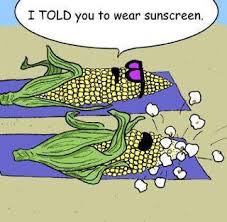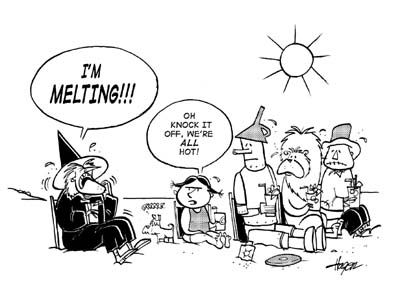
This is the everything-you-need-to-know-to-be-as-healthy-as-possible newsletter, brought to you by Kristy Russ, pharmacist and health consultant. I have over 20 years experience in helping people improve their health.
I help people get healthy, and more importantly, stay that way so they're not miserable and just slowly dying for the last 20 years of their lives, which IS the "norm" today.
For even more information go to
www.antioxidants-make-you-healthy.com
Hi,
As you read this it's highly likely that I'm basking in the sun, since I'm on vacation. Woohoo!
I admit it- I'm a sun worshipper. It's NEVER too hot for me and I absolutely love the feel of the sun on my skin and can't get enough of it. (Why do I live in Alberta, you ask? Well, I still can't convince my family to move, so...)
As much as I love basking in the sun, I'm well aware of the health consequences and do everything I can to protect myself from the damage of the rays. I know you've all heard the warnings for years, but bear with me and read to the end. I find that most people think they're preventing sun damage, but they're still not protecting themselves and their family properly...
Are You SURE You're "Sun Smart"?
The first thing to realize is that ANY amount of sun exposure (and it all adds up over the years) increases your risk of skin cancer (which is THE most common type of cancer in North America), eye damage and premature aging of the skin. That includes the 10 minutes you've been outdoors running errands everyday, not just when you're heading to the beach.
Of course, the best thing is to limit sun exposure by:
- Avoiding sun exposure between 11 am & 4 pm
- Wearing sunglasses
- Wearing a wide-brimmed hat and protective clothing (tightly woven, dark fabric is best)
- Using sunscreen religiously!!!!!
- Not using tanning beds!!!!! (More on this later)
But if you're like me and staying out of the sun is not a viable option, here's what you need to know...
A sunscreen with an SPF of at least 30 should be used (actually 15 would probably be okay if anyone ever applied it properly, but since over
85% don't, go with 30 to be safe). And here's the important thing most people don't know: Make sure that your sunscreen blocks both UVB and UVA rays. Most sunscreens only block UVB rays, which means you may not get a sunburn, but all the cancer and wrinkle causing rays (UVA) are getting through with no problem. Generally, a product that has your local Dermatologist Association logo on it is a good choice.
Sunscreen must also be used properly in order to be effective (the other area most people don't get right):
- Apply before any other skin products (eg. moisturizers, cosmetics)
- Apply generously. Most people don’t put enough on, which means you're not getting the full SPF- about 2-3 teaspoons per arm and 3-4 teaspoons per leg is the correct amount.
- Apply it 20-30 minutes BEFORE sun exposure. It needs time to bind with the skin to work. Most people
get outside, get settled and then pull out the sunscreen- by that time, a lot of damage has been done. I put it on before I leave the house. In fact, I often put it on before getting my swimsuit on- that way you don't get those lines by the edges that always get missed.
- Reapply every 2 hours and after swimming or exercising. Even if it's "waterproof", it can only handle about 10-15 minutes of water before losing its effectiveness.
Most people know that reflective surfaces like sand, water and snow increase your exposure- yes, you need it in the winter. What most people don’t realize is that cloud cover does NOT protect you. So, even if it doesn’t look sunny out, all rules still apply.
Surprisingly, clothing doesn’t offer as much protection as once thought either. Use a laundry detergent that has optical brighteners, such as Tide- they make clothing more reflective to UV rays.
Be extra diligent
protecting children, as excessive sun exposure at an early age seems to intensify the risk of skin cancer. And with all the time they usually spend outside, it's estimated that 80% of sun exposure happens by age 18. Babies less than 6 months old should be kept out of direct sunlight altogether- shade, hats and clothing are the preferred choice over sunscreen.
Load up on antioxidants to prevent the sun damage from actually happening. I get a lot of antioxidants through my diet and supplements every day (obviously, as the antioxidant guru, I think you might have guessed this). But when I'm spending a lot more time in the sun, I increase my supplements. Like right now on vacation, I am doubling my Proflavanol C100 dose to 4 tablets per day. It's a super potent antioxidant cocktail that will help inactivate the extra free
radicals I'm exposing myself to. I highly recommend this high quality product- click here to order it.
Okay, a quick word about tanning beds. There is no such thing as a healthy tan, nor are any beds less risky than others. A tan is your body’s reaction to cellular DAMAGE caused by UV rays. I know everybody feels better with a tan and feels they look better, but trust me, not only are you exposing yourself to needless medical risk, but you are actually prematurely aging your skin (ie: making yourself look older- and who wants that?) There are LOTS of self-tanning products available (and they’re much better than they used to be), so if you’re looking for that bit of color- THAT is the only way to have a healthy tan.
So, by all means, get out there and enjoy the summer with me (while it lasts). Just be sure to
protect yourself and prevent sun damage.
Another Grateful Customer...
"The components of the program make it so easy to follow. It's like 'Weight loss for Dummies'. I have never been able to stick with programs that require you to measure or weigh food. Too complicated and it takes the joy out of eating.
I'm loving the results I'm getting and I can't believe how much energy I have now!"
Wendy M.
Because Laughter Really IS Good Medicine...





